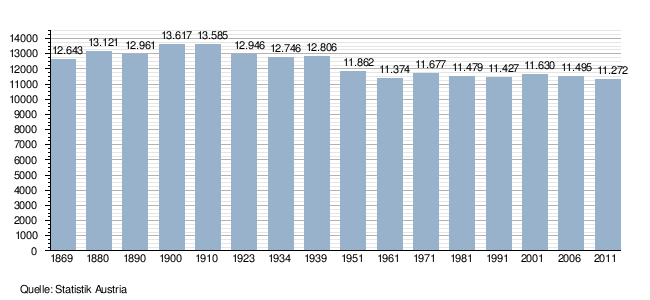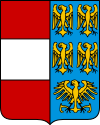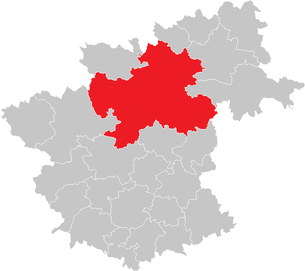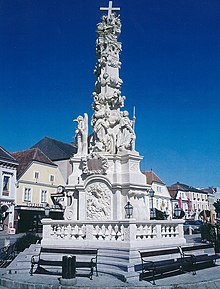Zwettl-Lower Austria
|
Borough Zwettl-Lower Austria
|
||
|---|---|---|
| coat of arms | Austria map | |
|
|
||
| Basic data | ||
| Country: | Austria | |
| State : | Lower Austria | |
| Political District : | Zwettl | |
| License plate : | ZT | |
| Surface: | 256.18 km² | |
| Coordinates : | 48 ° 36 ' N , 15 ° 10' E | |
| Height : | 520 m above sea level A. | |
| Residents : | 10,779 (January 1, 2020) | |
| Population density : | 42 inhabitants per km² | |
| Postcodes : | 3532, 3533, 3910, 3911, 3923, 3924, 3931, 3932 | |
| Area code : | 02822 | |
| Community code : | 3 25 30 | |
| NUTS region | AT124 | |
| Address of the municipal administration: |
Gartenstrasse 3 3910 Zwettl |
|
| Website: | ||
| politics | ||
| Mayor : | Franz Mold ( ÖVP ) | |
|
Municipal Council : ( 2020 ) (37 members) |
||
| Location of Zwettl-Niederösterreich in the district of Zwettl | ||
| Source: Municipal data from Statistics Austria | ||
Zwettl-Niederösterreich (usually only in the short form Zwettl ) is a municipality in northwestern Lower Austria . With 10,779 inhabitants and an area of 256 km², it is one of the largest municipalities in Austria in terms of area . At the 2011 census, the city itself had 3,922 inhabitants. This corresponds to the population of the cadastral municipality of Zwettl, which however does not correspond to the population of the entire city itself. Zwettl is also the capital of the district of the same name .
geography
The city lies at 520 m above sea level. A. in a basin (consisting of Gradnitztal, Sierningtal, Kamptal and Zwettltal) at the point of the upper Kamptal, where the Zwettl river flows into the Kamp. It is the geographic center of the community and is also the center of the Waldviertel .
Community structure
The community is divided into a total of 56 districts ( administrative districts ), 54 localities , and 61 cadastral communities .
|
structure
|
||||||
|
Legend for the breakdown table
|
||||||
|
|
The city of Zwettl itself includes Zwettl Stadt , with the old core town and the Syrnau district in the east, as well as the Oberhof districts in the north with the Bozener Siedlung northeast towards the Stift, and Propstei in the south. The village of Moidrams to the south-west has largely grown together with the city today.
The municipality of Zwettl-Niederösterreich, with a total area of 256 square kilometers, 61 cadastral municipalities, and most of the localities of all of Lower Austria, is one of the typical large municipalities . This is explained by the fact that the Waldviertel does not in principle have any pronounced scattered settlements , but rather formed numerous relatively compact locations. As in most federal states, these places retained their independence when the local parishes were created in 1849/50, but they are typical of Lower Austria both as a settlement-geographical unit (locality) and as a land register (cadastral municipality) as well as in the case of municipal amalgamations 20 independent municipalities united).
The municipality includes the following localities (population in brackets as of January 1, 2020):
- Annatsberg (101)
- Bernhards (5)
- Boehmhof (33)
- Bad Nines (26)
- Edelhof (0)
- Eschabruck (104)
- Friedersbach (471)
- Gerlas (33)
- Germanns (104)
- Gerotty (186)
- Gradnitz (121)
- Grossglobnitz (315)
- Grosshaslau (150)
- Gschwendt (154)
- Guttenbrunn (70)
- Hörmanns (84)
- Hörweix (32)
- Jagenbach (458)
- Jahrings (133)
- Kleehof (24)
- Little Mineharts (91)
- Kleinotten (133)
- Kleinschönau (114)
- Koblhof (42)
- Marbach am Walde (250)
- Mayerhöfen (37)
- Merzenstein (135)
- Mitterreith (135)
- Moidrams (255)
- Negro (41)
- Neusiedl (49)
- Niederglobnitz (71)
- Niederneustift (291)
- Niederstrahlbach (185)
- Oberstrahlbach (346)
- Oberwaltenreith (31)
- Ottenschlag (48)
- Purken (22)
- Ratschenhof (76)
- Rieggers (224)
- Ritzmannshof (5)
- Rosenau village (62)
- Rosenau Castle (51)
- Rottenbach (27)
- Rudmanns (579)
- Schickenhof (10)
- Syra Field (94)
- Lower Arabia (107)
- Unterrosenauerwald (125)
- Uttissenbach (55)
- Waldhams (168)
- Wolfsberg (71)
- Zwettl pen (410)
- Zwettl-Lower Austria (3835)
In addition, 6 of the cadastral communities ( Kühbach , Flachau , Oberndorf , Oberplöttbach , Pötzles , Wildings ) are depopulated former communities due to the creation of the Allentsteig military training area (1938–1945, some finally not until 1970, see list of settlements relocated for the creation of the Döllersheim military training area ) . A cadastral community, Koppenzeil , is only of historical importance and corresponds to the Propstei district.
The 55 administrative districts of the community - in addition to the city itself - largely correspond to the other cadastral communities and the localities and have a village chief , an office of a local right-hand man of the mayor. A special case is the district of Oberhof (also cadastral municipality), which has a local chief but is not counted as a separate locality by official statistics (on the part of Statistics Austria). Other exceptions are the village of Kleinmarbach , which belongs to the locality and cadastral community of Marbach am Walde, but has a head, and the village of Oberwaltenreith , which is statistically an independent village that belongs to the local board and the cadastral community of Eschabruck.
Neighboring communities
The large extent means that many other communities adjoin Zwettl. It is this
| Schweiggers , Kirchberg am Walde | Vitis , Echsenbach | Allentsteig |
| Groß Gerungs , Großschönau |

|
Pölla , Rastenfeld |
| Rappottenstein | Grossgöttfritz | Waldhausen |
climate
On February 12, 1929, Zwettl measured -36.6 ° C, the coldest confirmed temperature in an inhabited place in Austria. In Zwettl there is a transitional climate with continental influence from the east and oceanic influence from the west. The annual mean temperature in the 30-year mean 1971-2000 is 6.6 ° C and the total annual precipitation is 667.3 mm. In comparison with the values for the years 1981-2010, there are clear changes in temperature. As a result of climate change , the average annual temperature is around 0.9 ° C higher than in the period 1971–2000. Zwettl is characterized by many hours of sunshine in the summer months and long-lasting high fog blankets in winter. Due to the formation of cold air at night , low temperature minima are often measured. Despite the comparatively low altitude, these are often below the values of the Jauerling, which is around 400 m higher . Every year around 141 frost days and 37 ice days are recorded. As a result of the low daily warming caused by the altitude, around 28 summer days and 3 hot days occur per year. Around 90 cm of snow falls from November to April . In this respect, too, a decline has been recorded due to global warming . On a long-term average there are 25 thunderstorms and hail once a year.
|
Monthly average temperatures, precipitation and hours of sunshine for Zwettl (505 m)
|
|||||||||||||||||||||||||||||||||||||||||||||||||||||||||||||||||||||||||||||||||||||||||||||||||||||||||||||||||||||||||||||||||||||||||||||||||||||||||||||||||||||||||||||||||||||||||||||||||||||||||||||||||||||||||||||||||
history

The name Zwettl is of Slavic origin (cf. Czech Světlá , in Czech světlý = light, bright) and means something like clearing or clearing . This is confirmed by later documents in which the Zwettl monastery is named Claravallis (= light valley) in the Latin text . However, no Slavic remains have been found so far, so that no sources are known for a Slavic settlement other than the interpretation of the name.
The city founded by the Kuenringers is first mentioned in October 1139 in the founding document of the nearby Zwettl Abbey ( Cistercian abbey ). Zwettl has been a city since December 28, 1200.
In 1427 the city was besieged three times without success by the Hussites under the general Andreas Prokop in the battle of Zwettl . They destroyed and plundered Zwettl Abbey, three kilometers away, and most of the surrounding villages. The city also suffered badly in the Thirty Years' War , in 1618 Bohemian troops invaded the city and in 1645 it was occupied by Swedish troops.
The local community of Zwettl was constituted in 1850, and through the amalgamation of 13 communities in 1971, the city of Zwettl-Lower Austria was created in its current form.
In August 2002, heavy rains caused a devastating flood that caused great damage. The records of the city's over 800-year history report no comparable flood disaster.
Population development

politics
Municipal council
After the 2020 municipal council elections , there will be 37 seats in the municipal council as follows: ÖVP 29, Greens 4, FPÖ 2 and SPÖ 2.
In the term of office of the municipal council from 2010 to 2015 there were 51 mayor for the administrative district. Four of the heads look after two districts (Eschabruck and Oberwaltenreith, Großhaslau and Ritzmannshof, Purken and Bernhards, Rudmanns and Edelhof).
mayor
Franz Mold (ÖVP) has been the mayor of the city of Zwettl since October 2018 . In September 2018 Herbert Prinz announced his resignation as mayor after 14 years in office. On October 9, 2018, Franz Mold, member of the state parliament, was elected as his successor as mayor of Zwettl.
- 2004–2018: Herbert Prinz (ÖVP)
- since October 2018: Franz Mold (ÖVP)
coat of arms
The split coat of arms shows the silver band (bar) in front on a red field (Austrian band sign ) and in the back five (2; 2; 1) golden eagles ( Lower Austrian coat of arms ) in blue .
Partner communities
The city of Zwettl maintains city partnerships to exchange experiences. There is a partnership with the municipality of Zistersdorf in the Gänserndorf district. International partner cities are Plochingen in Baden-Württemberg and Jindřichův Hradec in the Czech Republic.
Culture and sights
- Parish church Friedersbach
- Parish church Marbach am Walde and cemetery chapel Marbach am Walde
- Large parts of the medieval town center have been preserved to this day. These include the largely still existing city wall, six city towers, the old town hall (built in 1307) and some historic town houses. In 1994, as part of the redesign of the main square, a fountain designed by Friedensreich Hundertwasser was built.
- Propstei Zwettl : South of the old town is the Propstei Zwettl with remarkable Romanesque components. The Propstei Zwettl consists of a Romanesque church and the adjoining Michael's chapel, a cemetery with a Romanesque charnel house, the actual provost building and a former parsonage - the so-called "box". In front of the listed complex there is a monumental sandstone crucifixion group at the end of the Way of the Cross . The provost church is one of the oldest preserved structures in the city. It is considered likely that the Kuenringerburg mentioned in the " Bärenhaut " was located on the area of today's Propstei and that the church - the first parish church of Zwettl - was built around the same time as the castle complex.
- A spiritual center and cultural monument of high standing is the Zwettl Abbey, northeast of the city, with the Zwettl Abbey Church of the Cistercians .
- Trinity column by the sculptor Johann Caspar Högl from Eggenburg .
- A few kilometers west of Zwettl is Rosenau Castle with its Freemason Museum.
- The step cone in the Waldviertel lies between Zwettl and Groß-Gerungs .
- The Zwettler city wall is a medieval fortification that surrounds the historic old town. Until the beginning of the 13th century, Zwettl was only protected by wooden palisades . The construction of a quarry stone wall began in 1229 in connection with the first city expansion. After severe damage by the armed forces of Babenberger Frederick the Armed Forces in the suppression of the ministerial uprising in 1231, it was rebuilt a year later and reinforced with towers and a wall. Its further expansion lasted until the 15th century. As a result of the war techniques that emerged at the end of the Middle Ages, the city wall lost its direct military function, but was still maintained, as in many other medieval cities. In 1590 the drawbridges at the gates were replaced by stone bridges. Two fortification towers had to give way around 1610 and around 1800 the city moat was drained. Although other large parts of the newly laid streets and buildings fell victim in the 19th century, six defensive towers, remains of a moat and well-preserved masonry with a total length of about one kilometer have been preserved. The former gateways have completely disappeared; The portal of the parish church, however, features a west tower with a round-arched street passage, which historian Adalbert Klaar believes once served as the inner fortification tower of the Lower Gate. The preserved parts were placed under monument protection in 1965 .
- The old town hall on the main square is a widely redesigned, gable-independent building with a slightly protruding tower and a Gothic core. The exact construction time is unknown. It was first mentioned in a document at the beginning of the 14th century in connection with Leuthold von Kuenring . Thus it is one of the oldest secular buildings in the city. There are many indications that it originally served as the residence of the Kuenringers. The Zwettler citizenship acquired the building in 1483 to use it as a council and court building. It served this purpose until 1975. In 1992 a city museum was set up, which shows, among other things, the so-called Anton collection. During a restoration in 1976, sgraffiti from the mid-16th century were uncovered on the facade . While the paintings on the tower and in the window zone are still in a good state of preservation, those on the ground floor and on the gable field have been almost completely destroyed. The representations relate to the function of the building as a court and administrative center.
- The Catholic parish church Zwettl-Niederösterreich is located at the beginning of the Landstrasse in the area of the former lower gate of the medieval city wall. It is mentioned for the first time in 1280 as ecclesia inferiora ('lower church') and named in a document from 1352 as the Frauenkirche. The exact construction time is not known. Presumably it was built as a pillar basilica with three naves in the late Romanesque style as early as the first half of the 13th century and was later rebuilt and expanded several times.
- The Evangelical Church in Zwettl-Niederösterreich was consecrated in 1904.
- The Trinity Column (also: Plague Column ) in the old town of Zwettl is a monument in the Baroque style , which was created by the Eggenburg sculptor Johann Caspar Högl in 1727. The prismatic sandstone pillar rises above a mighty volute base, is decorated with garlands of clouds and surrounded by a stone balustrade. He has reliefs of St. Rosalia, Johannes Nepomuk and Donatus as well as flanking figures of St. Sebastian, Rochus and Florian. It is crowned by a group of figures of the Trinity .
- The Hundertwasser fountain on Zwettl's main square was designed in 1994 by the Austrian artist Friedensreich Hundertwasser . Its main elements are two fountain columns with collecting trays and a pavilion. There used to be a war memorial at this point, which was moved to its new location by the Johannes Nepomuk Chapel on the occasion of the redesign of the square.
Economy and Infrastructure
traffic

Zwettl is located on Zwettler Straße B36 from Dobersberg to Persenbeug and Böhmerwald Straße B38 from Kollerschlag to Horn (with a junction to Krems - Kremser Straße B37), which are to be expanded in the near future, as they are increasingly frequented.
Furthermore, the construction of a bypass is about to be implemented in the next few years.
The development of the city by the railroad is guaranteed by a line section of the Schwarzenau – Zwettl – Martinsberg local railway, opened in 1896, with the station on the northern outskirts of the city. The local railway line connects Zwettl with Schwarzenau and thus with the Franz-Josefs-Bahn . In 2010 passenger traffic was discontinued after 114 years, freight traffic still exists. It took about two and a half hours by train from Zwettl, including changing trains in Schwarzenau, to the federal capital Vienna, and about an hour and forty minutes by car. Since the line was closed, Zwettl has belonged to Waidhofen an der Thaya, Güssing, Oberpullendorf and Oberwart as one of the five district capitals in Austria without any connection to public rail passenger transport.
Numerous bus lines, including routes on the Waldviertel line, connect Zwettl with other important communities in the Waldviertel such as Krems or Gmünd and with the Franz-Josefs-Bahn. Furthermore, a city bus line operated by ÖBB-Postbus GmbH runs within Zwettl on working days , which also goes to some cadastral communities and the monastery.
education
In addition to several elementary schools and two new middle schools , Zwettl has a grammar school , a commercial academy, a branch of the Kremser HTL for information technology and an adult education center. Schools of the Franciscan Sisters: elementary school, middle school, technical school and higher educational institute for economic professions, educational institute for social pedagogy and a college for elementary pedagogy
Established businesses
There are hardly any industrial companies in Zwettl, but mainly small and medium-sized trading and commercial operations. On February 17, 2000, Zwettl was given the nickname "Braustadt" to honor the centuries-old brewing tradition in the city; Today there is only one brewery left in Zwettl, the Zwettl private brewery with an output of around 200,000 hectoliters (as of 2008), which can look back on a 300-year tradition.
Other important local companies are the Kastner companies (wholesalers and retailers) and the AVIA Eigl group (energy trading: petrol stations, mineral oils, pellet production , lubricants ).
At its center, Zwettl has an intact inner-city business landscape with a good mix of industries . There is also - as in most of the other district capitals - a retail park on the green field.
Personalities
Honorary citizen
- Franz Josef Eigl (1925–2002), Mayor of Zwettl
- Franz Forstreiter (1828–1908), Mayor of Zwettl
- 2019: Herbert Prinz, Mayor of Zwettler from 2004–2018
sons and daughters of the town
- Anton Anderl (1909–1988), member of the Lower Austrian state parliament
- Karl Eichinger (* 1965), pianist
- Peter Fichna (* 1931), ORF radio and television speaker
- Hans Forstreiter (1895–1973), painter
- Karl-Heinz Frankl (1938–2019), Roman Catholic priest and church historian
- Karl Hafner (1905–1945), teacher and writer
- Andreas Haider-Maurer (* 1987), tennis player
- Josef Haslinger (* 1955), writer
- Christoph Jank (* 1973), football player
- Josef Leutgeb (1933–1983) Austrian editor-in-chief , publicist , newspaper publisher, author and local researcher
- Florian Metz (* 1985), soccer player
- Clemens Moser (1806–1875), Benedictine and politician
- Robert Neumüller (* 1959), cameraman and director
- Andreas Daniel Onea (* 1992), swimmer and disabled athlete
- Johannes Preiser-Kapeller (* 1977), Byzantinist
- Johann Michael Puchberg (1741–1822), cloth merchant, patron and administrator of Mozart's estate
- Erich Slatner (1935–1975), painter, graphic artist and art teacher
- Linde Waber (* 1940), painter and graphic artist, world traveler in studios
- Andrea Wagner (* 1975), politician ( ÖVP )
- Melchior von Zaunagg (1667–1747), Dept.
literature
- Hermann Maurer : The prehistoric and early historical finds of the Zwettl district , Sallingberger Heimatbuch, 1983, p. 19ff.
- Castles, pens and palaces. Regions Waldviertel, Danube Basin, South Bohemia, Vysočina, South Moravia. ISBN 978-3-9502262-2-5 , pp. 140 f.
Web links
- 32530 - Zwettl-Lower Austria. Community data, Statistics Austria .
- Entry on Zwettl-Niederösterreich in the database of the state's memory of the history of the state of Lower Austria ( Museum Niederösterreich )
Individual evidence
- ↑ The official spelling is specified or represented in the law on the division of the State of Lower Austria into municipalities, LGBl.No. 1030–94 of December 9, 2011 and on Statistics Austria: A look at the municipality
- ↑ Statistics Austria - Population at the beginning of 2002–2020 by municipalities (area status 01/01/2020)
- ↑ Register census from October 31, 2011: Population by locality. (PDF; 12.1 KB) Municipality: Zwettl-Niederösterreich (32530). In: statistik.at. Statistics Austria, July 31, 2013, accessed on August 15, 2017 .
- ↑ Statistics Austria: Population on January 1st, 2020 by locality (area status on January 1st, 2020) , ( CSV )
- ^ Antonín Bartoněk, Bohuslav Beneš, Wolfgang Müller-Funk and Friedrich Polleroß : Kulturführer Waldviertel, Weinviertel, South Moravia , Vienna 1996, p. 401, ISBN 978-3-216-30043-0
- ↑ Certificate No. 36 in Friedrich Hausmann (Ed.): Diplomata 21: The documents of Konrad III. and his son Heinrich (Conradi III. et filii eius Heinrici Diplomata). Vienna 1969, pp. 58–60 ( Monumenta Germaniae Historica , digitized version )
- ↑ Mayor - All. City of Zwettl-NÖ, accessed on September 28, 2012 . ; New appointment and swearing-in of the mayor. City of Zwettl-NÖ, accessed on September 28, 2012 .
- ↑ a b c Brigitte Lassmann-Moser: Successor to Prince - Franz Mold elected as the new city chief of Zwettl. In: noen.at . October 10, 2018, accessed April 9, 2020.
- ↑ Zwettl's mayor resigns: “Right time”. In: mein district.at . October 1, 2018, accessed January 3, 2020.
- ↑ a b Jürgen Zahrl: Mold succeeds Mayor Herbert Prinz. In: kurier.at . September 29, 2018, accessed on January 7, 2020.
- ↑ a b DEHIO Lower Austria north of the Danube . Berger, Vienna 2010, ISBN 978-3-85028-395-3
- ^ Nicole Alexandra Pieper: The city wall of Zwettl, Lower Austria. Architectural archaeological studies (diploma thesis). Institute for Prehistory and Protohistory at the University of Vienna, Vienna 2009. PDF
- ↑ Thomas Kühtreiber , Roman Zehetmayer: To the history of the Propsteiberg . In: Zwettler Zeitzeichen . tape 2 . Stadtgemeinde Zwettl-NÖ, Zwettl 1999, ISBN 3-902138-01-7 , On the history of the castle and the parish Zwettl according to written sources, p. 32 f .
- ^ History of the museum. In: stadtmuseum.zwettl.at. Retrieved August 22, 2020 .
- ↑ Anton Collection. In: stadtmuseum.zwettl.at. Retrieved August 22, 2020 .
- ↑ Friedel Moll: The construction of the Trinity column. In: zwettl.gv.at. October 2003, accessed September 24, 2019 .
- ↑ The Hundertwasser fountain on the main square. In: zwettl.at. City of Zwettl-Niederösterreich, accessed on July 15, 2020 .
- ↑ Street names in the new industrial park. Entry on the website of the Zwettler City Archives. In: zwettl.gv.at. October 13, 2010, accessed May 22, 2020 .
- ↑ Katrin Pilz: Former Mayor Herbert Prinz is an honorary citizen. In: mein district.at. April 21, 2020, accessed April 21, 2020 .








